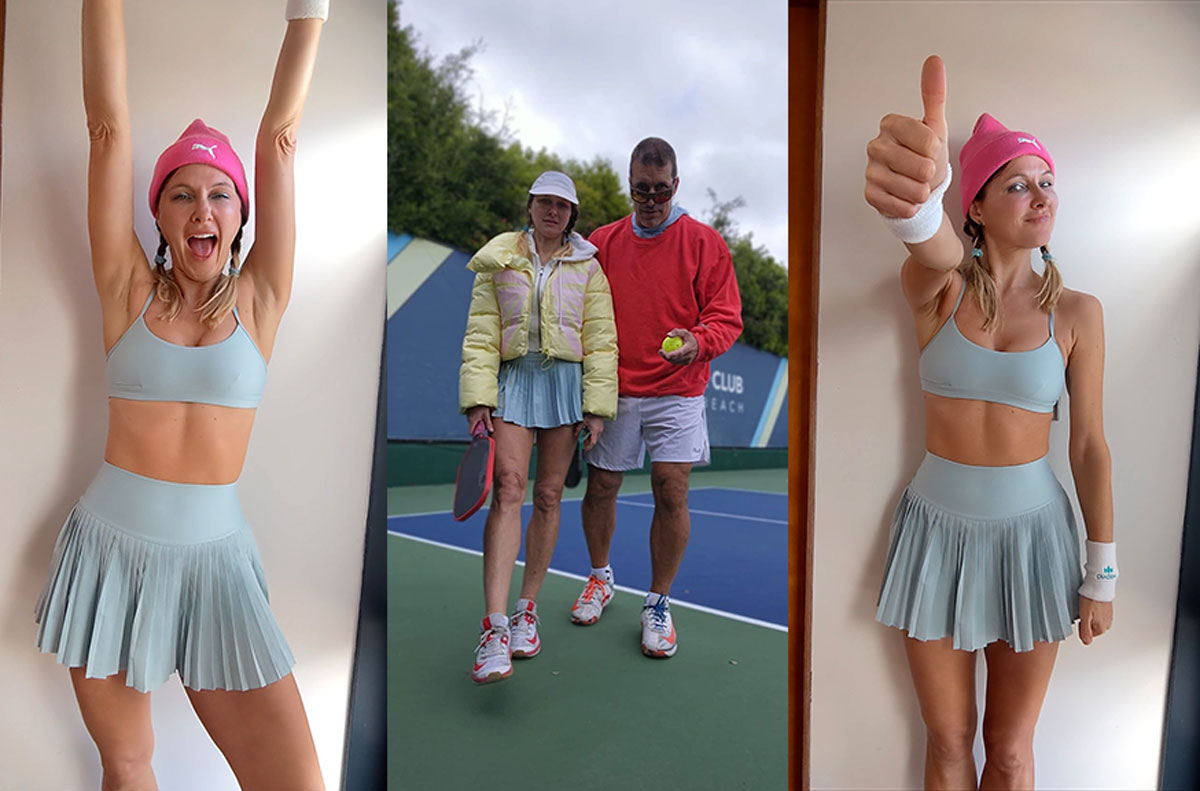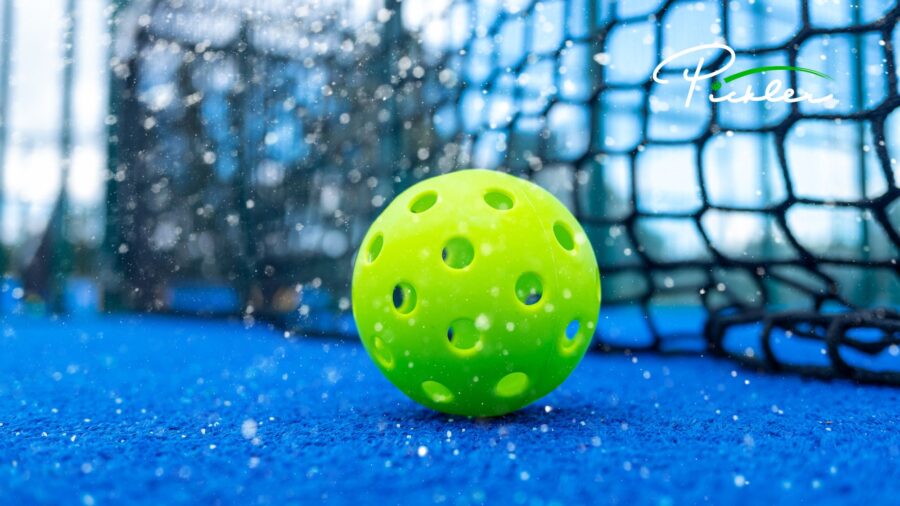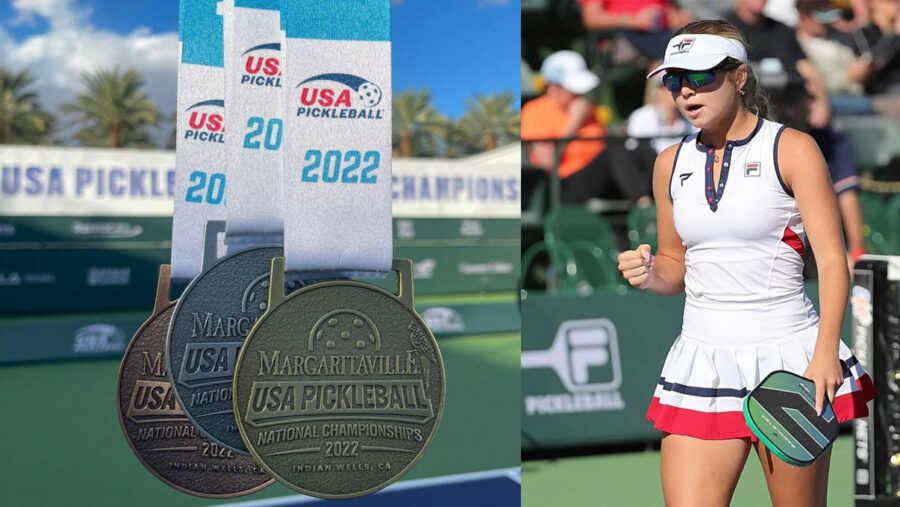The rules of pickleball are one of the most debated issues in the sport. For instance, pickleball players have weighed in on whether the spin serve be permitted, or what rises to the level of a hindrance. And, now, after a recent pickleball tournament in Newport Beach, California, pickleball players may need to weigh in on what is considered “inappropriate” clothing for pickleball.
The series of events in California are generally not in debate by the parties involved. However, how those events are interpreted, and how the pickleball rules are applied to those events, are subject to debate by the parties involved.
Dominika Julliet and her boyfriend and mixed doubles partner, Nick Bicanic, took to a court to warm-up for their bracket on the day. Julliet wore a matching set manufactured by the popular brand Alo (which is marketing to pickleball players and has notably sponsored pro pickleball players like Parris Todd). The Alo set featured a light blue free-flowing skirt and a matching sports top (depicted below).
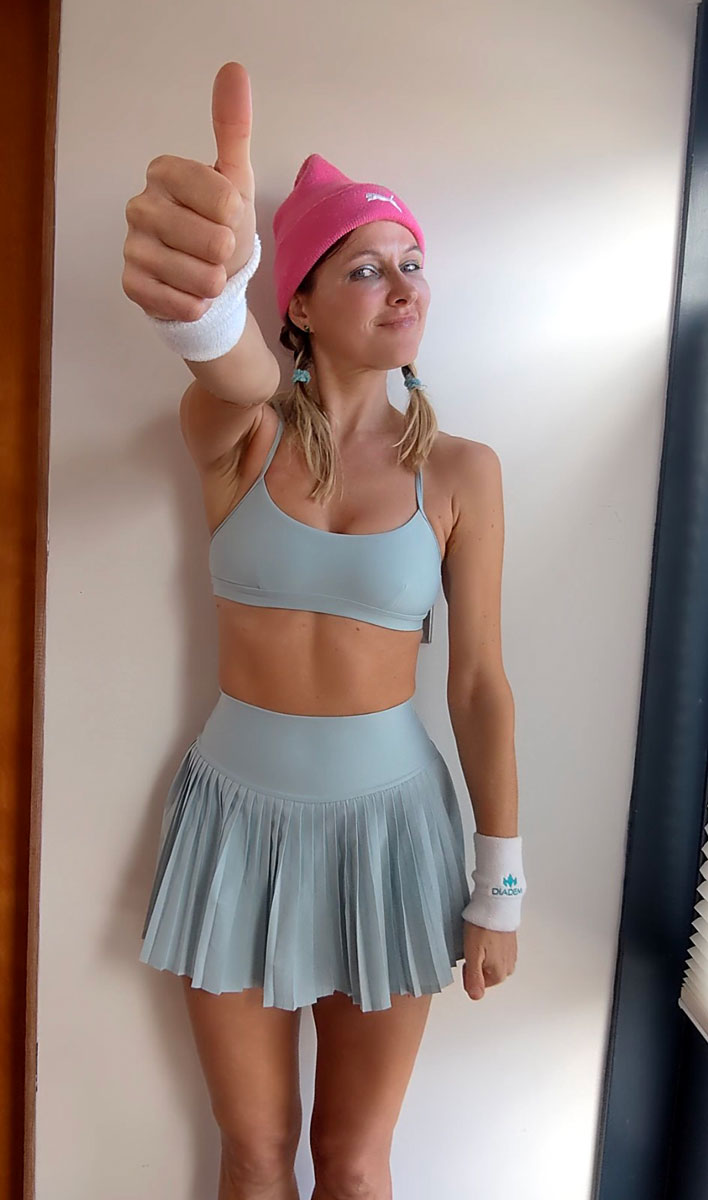
This is a popular outfit amongst Julliet and other fellow pickleballers, as Julliet has worn the same outfit at another pickleball tournament at the same Newport Beach venue, and other pickleballers, Annie Davidson and Melissa Nespor, also wore the matching outfit at other local tournaments in the state.
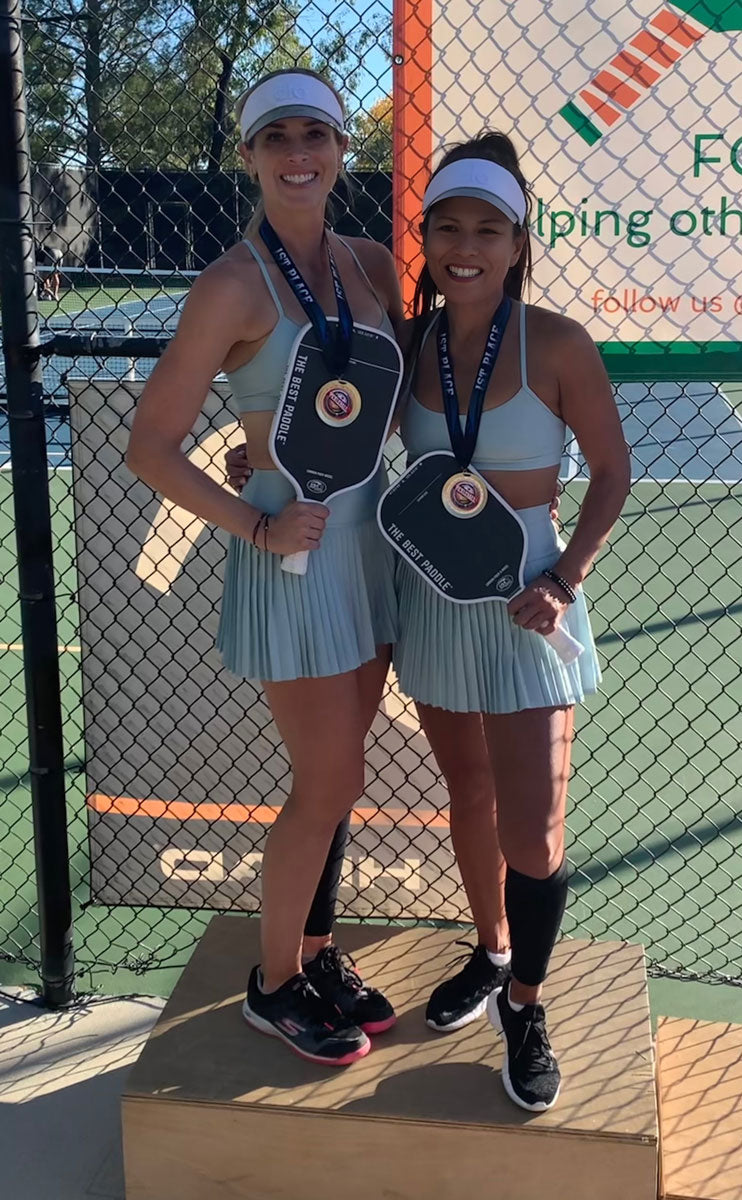
During Julliet and Bicanic’s warm-up, the tournament director, Pat Rolfes, and head referee, Claire Cavanagh, approached Julliet courtside (which, according to Rolfes, was “in an effort to minimize disruption to her play”), as a complaint was made by another anonymous female player that Julliet’s outfit was “too distracting” due to (according to the anonymous complaint) the amount of cleavage that she was showing and the motion of her cleavage when in action on the court. Rolfes and Cavanagh alerted Julliet of the complaint and required her to wear additional clothing to cover up.
After some back-and-forth discussion and negotiation between Julliet and Cavanagh, Julliet, who was flustered by the complaint and being approached on the court in a public setting, obliged to wear an additional light top in an effort to avoid confrontation (despite Julliet noting that other individuals were dressed in a similar manner on nearby courts). During this back-and-forth discussion and negotiation, Julliet raised her concerns with the concept of adding layers, as she disclosed that she has a medical condition that causes her to overheat easily, so covering up with additional layers poses a health risk.
With the new agreement to wear the outer layer, Julliet continued her warm-up with her partner. Shortly thereafter, she removed her outer layer for some reprieve before her match. At which time, Julliet was immediately approached by Cavanagh and another representative to remind her that she needed to wear her outer layer. This exchange included some words by the other representative that were insensitive toward Julliet’s chest anatomy and her raised medical condition, which was later apologized for by Rolfes.
Julliet put on her outer layer and played on in her mixed doubles bracket for the day, eventually going 1-2 with her partner.
Along the way throughout the day, Julliet had a civil conversation with Rolfes to voice her disagreement with the day’s events and discuss how much subjectivity the rules provide when it comes to clothing and apparel on the pickleball courts—which the official rules of pickleball set forth by USA Pickleball provide the following when it comes to apparel (Rule 2.G of the USA Pickleball Official Playing Rules):
As the arbiters of the rules for the pickleball tournament, Rolfes and Cavanagh applied these apparel rules to Julliet and her outfit of the day. Rolfes and Cavanagh approached Julliet to address her outfit that was complained to be “too distracting” (and, thus, inappropriate). As a result, Julliet was required to comply with the apparel change (which Julliet and Cavanagh agreed to).
Later in the evening, upon further reflection, Julliet took exception to this application of the rule and even wished that she did not play. She even noted that she does not want to play at all if she has to worry about someone approaching her to talk about her cleavage. Julliet felt targeted right before her event and felt as if she had no way to counter a very subjective rule. She felt judged for her body and how she decided to dress by those in charge and, as a result, felt she had misplaced shame for she had nothing to be ashamed of. Julliet stated that “I was forced to worry about my wardrobe, when all I should have been worried about was warming up my backhand dink.”
This series of events begs the question of where does pickleball “land” on appropriate court attire? Should pickleball have a dress code? And, if so, who should be the ones to dictate what players can and cannot wear? Is that USA Pickleball’s responsibility or is it the responsibility of local facilities and event organizers? When and how should these new rules be communicated to players? And, should there be any exceptions to the rule for any reason (such as a medical condition, like the one raised by Julliet)? The answers to these questions will become a growing issue as more and more people take to the pickleball courts. This is particularly true as the sport of pickleball grows younger, gets more democratized (as everyone is welcome), and looks more and more like the new “town square” where people gather and socialize. So, should apparel be dictated in these circumstances?
If you ask the parties involved in the Newport Beach circumstance, you will receive many different answers and viewpoints:
- Player at Issue, Julliet – Julliet believes that the rules of pickleball should be about safety. Your clothes should not put you in jeopardy of injury, you should not wear the same color as the ball (which is clearly stipulated by the rules), and you should not be exposing yourself. Outside of that, you should be able to wear what you want, which is an act of self-expression and part of the joy of pickleball. Everyone is welcome and you can be authentic to yourself on the pickleball courts.
- Others that Have Worn the Same Outfit, Nespor and Davidson – Nespor, “feel[s] that the only rule on attire is that you need to wear clothing. What you choose to wear is your own choice.” While Davidson notes that “This is not a forced uniform, this is our choice. My partner [Nespor] and I spend a lot of money and time on what we decide to wear and honestly, it’s one of the fun parts of the game. We both take pride in what we choose to wear for tournaments and, as a mother of 3 small children, I am proud of my body and what it allows me to do on the courts!”
- Tournament Director, Rolfes – Rolfes stands by the decisions and actions taken on the day in Newport Beach. He notes that Julliet and Cavanagh agreed to the compromise and he did not make any determinations or decisions on the matter as the tournament director. However, Rolfes believes that it is USA Pickleball’s responsibility as the governing body to provide more specific rules on apparel, so that there is more guidance to (and less discretion by) the tournament directors and referees. According to Rolfes, a set of rules and standards from USA Pickleball would lead to more consistent and controlled application of apparel rules.
- USA Pickleball Association – USA Pickleball provided the following statement on this issue of apparel: “USA Pickleball intentionally does not define clothing standards within its Official Playing Rules, beyond recommending that ‘appropriate’ apparel be worn. What may be allowable in one part of the country, or at one event or venue, may not be allowable elsewhere. So, it would be unfeasible for USA Pickleball to mandate — and attempt to enforce — clothing rules that may be more, or less, restrictive than what is locally acceptable. USA Pickleball therefore encourages event organizers, facility operators and league/club leaders to provide guidance in advance to all players, including through pre-tournament instructions.”
Pickleball is not the first sport to face a question of who should dictate athletes’ clothing. This is particularly true in women’s sports, as apparel debates have arisen in beach volleyball (where certain players protested the requirement to wear bikini bottoms), gymnastics (where certain gymnasts decided to wear full-body leotards), soccer (recall Brandi Chastain ripping off her jersey and displaying her sports bra in the 1999 Women’s World Cup), among others.
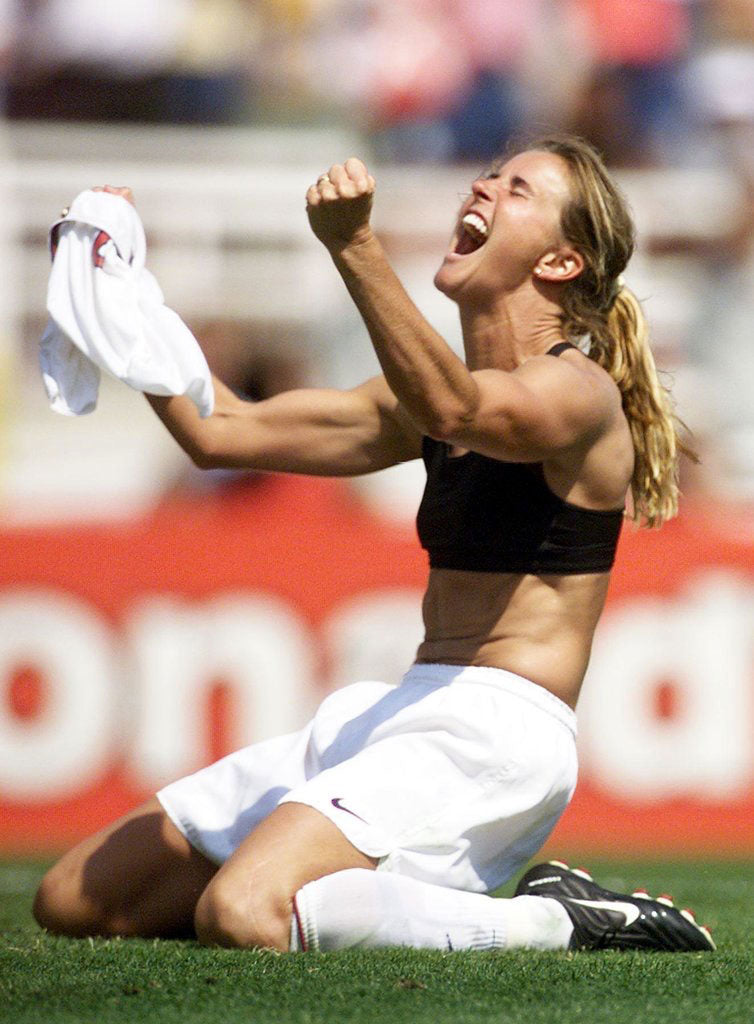
Tennis great Serena Williams even sparked controversy after playing in her cat suit at the 2018 French Open. However, being such a young and growing sport, pickleball is now forced to face a similar issue as some of its more long-tenured counterparts.
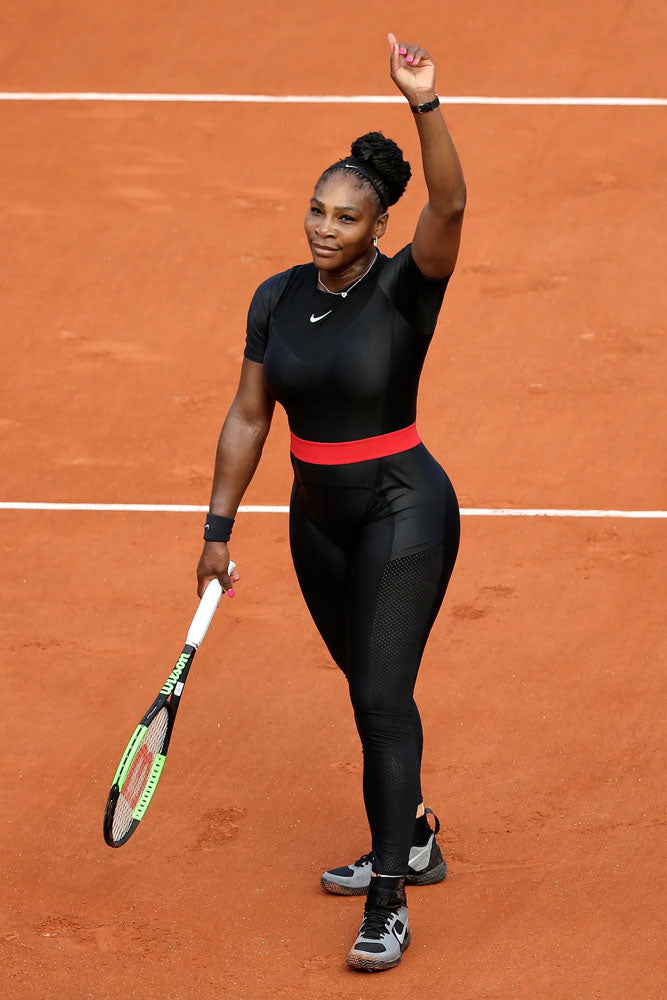
This issue on apparel does not just affect women (although, based on the history of sports, this issue oftentimes affects women to a greater extent). It also applies to men. For instance, should men be permitted to play shirtless? Could a male player be wearing shorts that are “too tight” or “too short”? Further, what about pickleball players that intentionally dress in a more “flamboyant” manner? For instance, are the outfits of pickleball player and coach Gizmo Hall—who is well-known for dressing in bright colors, covered in hamburger patterns, and usually has unmatched socks and shoes—“appropriate” under the rules?
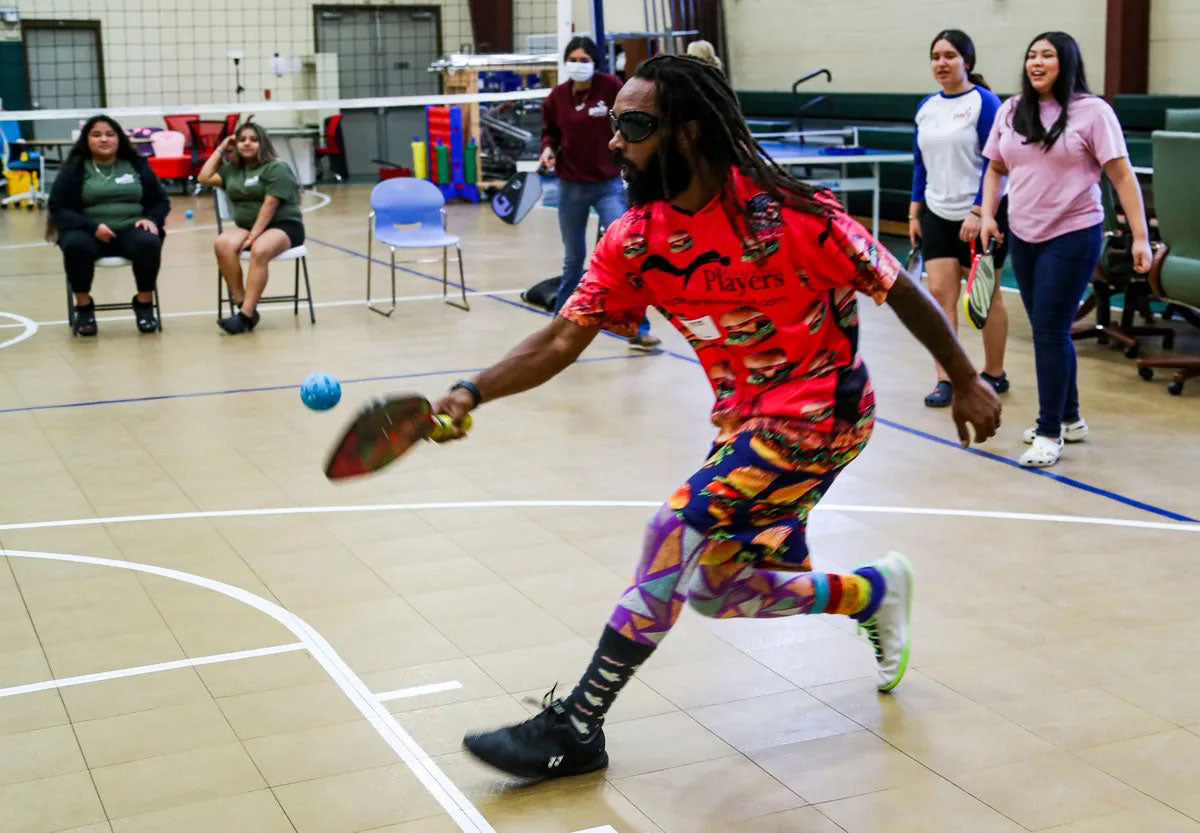
Currently, there is no set look in the sport of pickleball. Should there be any rules or parameters on an athlete’s determination of his or her outfit of the day for the pickleball courts? What is “appropriate” or “inappropriate” for the pickleball courts? Or, is the player to determine what “looks good”? As they say, “look good, feel good, play good”…

